Pigneto is a multifaceted neighbourhood. Most recently it has become Rome’s hub for art and creativity, prone to house trendy haunts, lively nightlife, organic supplies and checked shirts. Some call it Pigneto Village, but as its streets still maintain the shabby feel of a 20th-century suburban district, this seems somewhat misguided.

Underneath the aqueduct’s arches (Photo: Steve Browne, John Verkleir via Flickr)
Pigneto shows up on the map as a triangle-shaped area in south-east Rome. Contained within the ancient consular roads, Via Casilina and Via Prenestina, it was formerly the land of two noble farmsteads, up until the late 19th century. Then factories and impromptu residential settlements transmogrified the area, especially during the 1920s, fomenting its working-class character.
Porta Maggiore marks the western corner of Pigneto. A monumental gate dating back to 52CE, it marked the intersection of eight of the 11 aqueducts of Ancient Rome, and was later included in the city walls built by Emperor Marcus Aurelius. The curious tomb of Eurysaces the Baker faces the gate with the typical elements of a Roman bakery, including a relief guide to bread-making. A short distance away, the Basilica di Porta Maggiore is ensconced seven metres under ground. The original function of the mythological scenes depicted in its vaults remains uncertain (open only by appointment). The arches of Acquedotto Claudio, running harmoniously along Via Casilina, provide further archaeological testimony to the greatness of Ancient Rome.
Fast-forwarding through history, a few buildings in the west part of Pigneto show its 20th-century industrial roots, such as former Pantanella pasta factory (now a housing estate) and Serono pharmaceutical factory (now a high-end hotel). Piazza Caballini is where Rome’s first horse tram depot was built in 1891. From there, Via del Pigneto runs eastwards, becoming a pedestrian area when it reaches the heart of the neighbourhood.
Every morning, except on Sundays, this area hosts the historic Mercato Casilino, which supplies locals with fruit and vegetables, fish, meat and homeware. A recent renovation considerably reduced it in size, but the market still reflects the multicultural, community-driven streak of Pigneto.
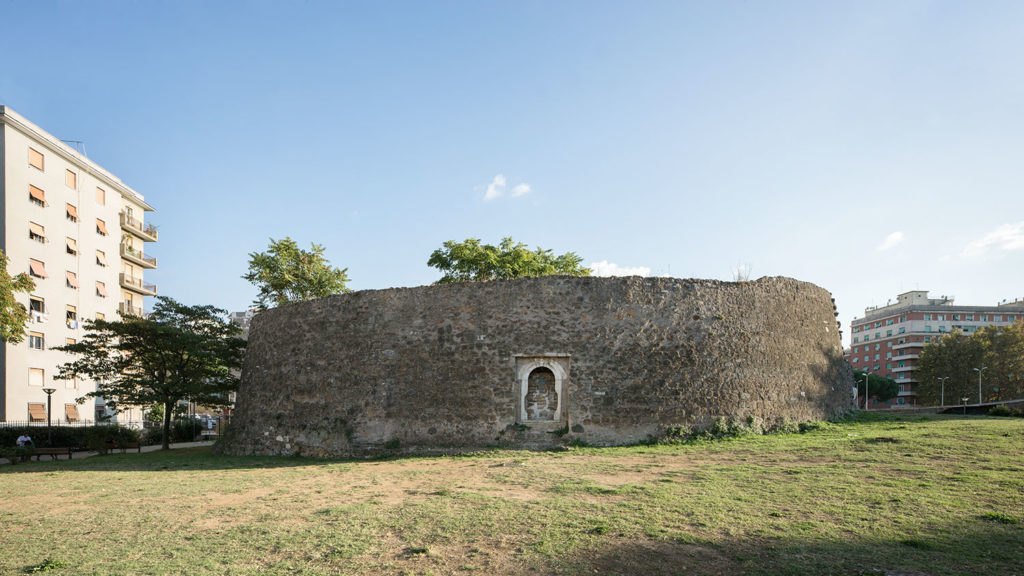
Torrione Prenestino seen from the park (Photo: Federico di Iorio via Wikimedia)
Further along Via del Pigneto, the urban landscape makes way for the Liberty-style villini (detached houses), also known as the “railwaymen area”. This residential complex was built by railway employees’ cooperatives during the 1920s, following the example of wealthier, better-known areas of the city.
It is perhaps due to such legacy that the local toy museum, often overlooked, houses a toy railway-landscape, whose size and scale are bound to impress train buffs. Focusing on the 20th century, this ethnographic museum also displays vintage dolls and toys once belonged to Fritz Billing Hoenisgberg, a Jewish-Austrian who started his collection as he was fleeing to the US to escape Nazism (Museo Storico Didattico di Giochi e Giocattoli del Novecento, Via Vincenzo Coronelli 24/26a).
Street art is another highlight of Pigneto. Signed by art collective Etam Cru, a 32 metre-high man sipping his coffee while standing in a garbage bin won’t go unnoticed on the crossroads between Via del Pigneto and Via Pavoni. Several more murals adorn the walls and facades of the neighbourhood, lending it yet another dose of personality.
Other traces of Ancient Rome can be found along the northern border of Pigneto, Via Prenestina. Sepolcro di Largo Preneste is a funerary building dating back to the 2nd century AD, while Torrione Prenestino is one of Rome’s biggest mausoleums. As a result of bombings in World War II and later urban renewals, only part of the original mausoleum is still in place, and is not currently open to the public.
Via Montecuccoli may not appear noteworthy, but some people will recognise it as the setting for a key scene of ‘Roma Città Aperta’, a seminal Neorealist film by Roberto Rossellini. Another director known for his imagery of Pigneto is Pierpaolo Pasolini, whose 1961 film ‘Accattone’ tells the story of a local pimp chasing his little share of holiness. In the film, Bar Necci is where Accattone’s clique regularly gathers, the perfect spot to start roaming around the haunts of Pigneto once the nightlife replaces the morning market.
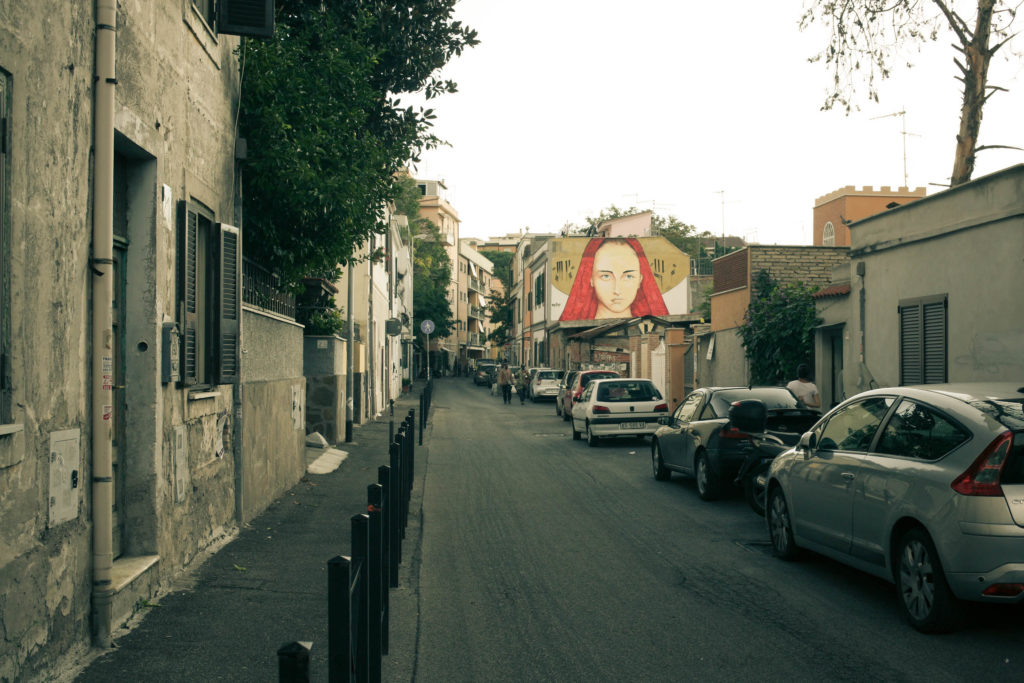
Street art in Via Fanfulla da Lodi (Photo: Davide Costanzo via Flickr)
Eat and Drink
Necci (Via Fanfulla da Lodi, 68) has much changed since Pasolini shot ‘Accattone’, but tributes to the Italian director still decorate its 1960s-themed interiors. The quiet terrace garden makes for a peaceful refuge from the city. Enjoy anything from a breakfast coffee to a late-night drink, by way of artisan desserts and aperitivi. The food menu features modern Italian cuisine with an inevitable penchant for Roman classics; more than enough to cater to the eclectic clientele of this Pigneto icon.
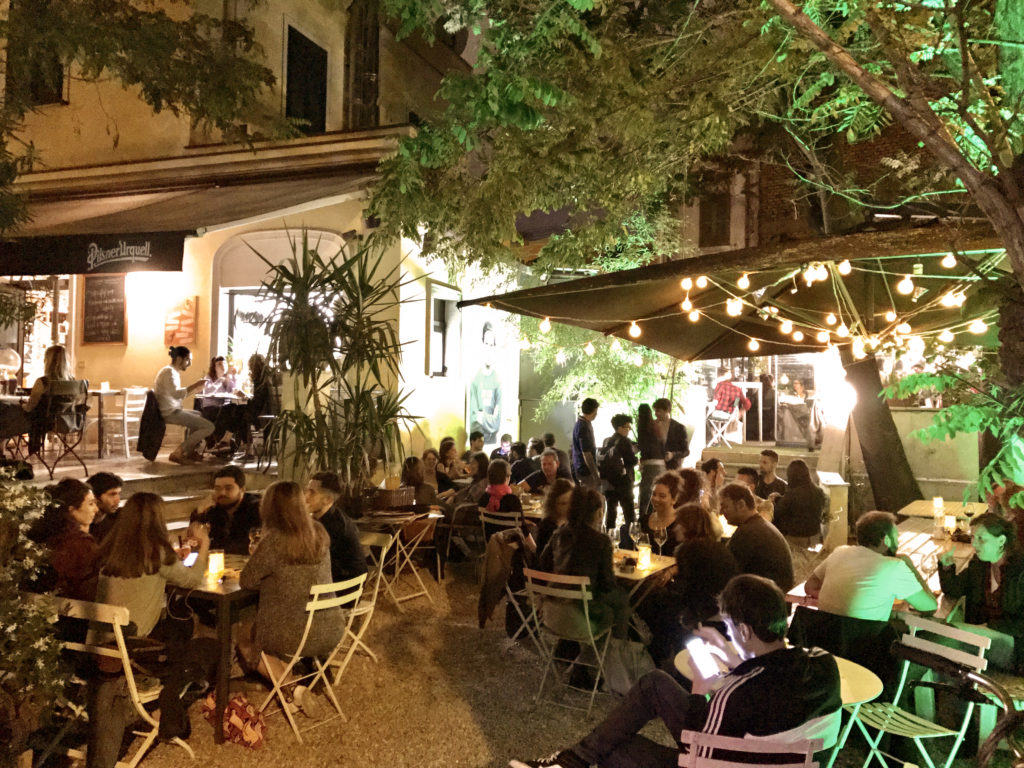
Necci’s garden by night (Photo: Necci)
First restaurant of the pedestrian area, Infernotto (Via del Pigneto, 31-33) opened in 1995 to quickly establish itself as part of the fabric of the neighbourhood. Casual, yet refined, Infernotto offers a thorough selection of wine and a creative menu where local flavours meet a broader Mediterranean taste. Favourites on a sample menu include artichokes and pancetta tonnarelli, octopus on chickpea purée, beef tajine and vegetarian cous cous. Aperitivi and after-dinner drinks are also available, as Infernotto is open from 6pm until late.
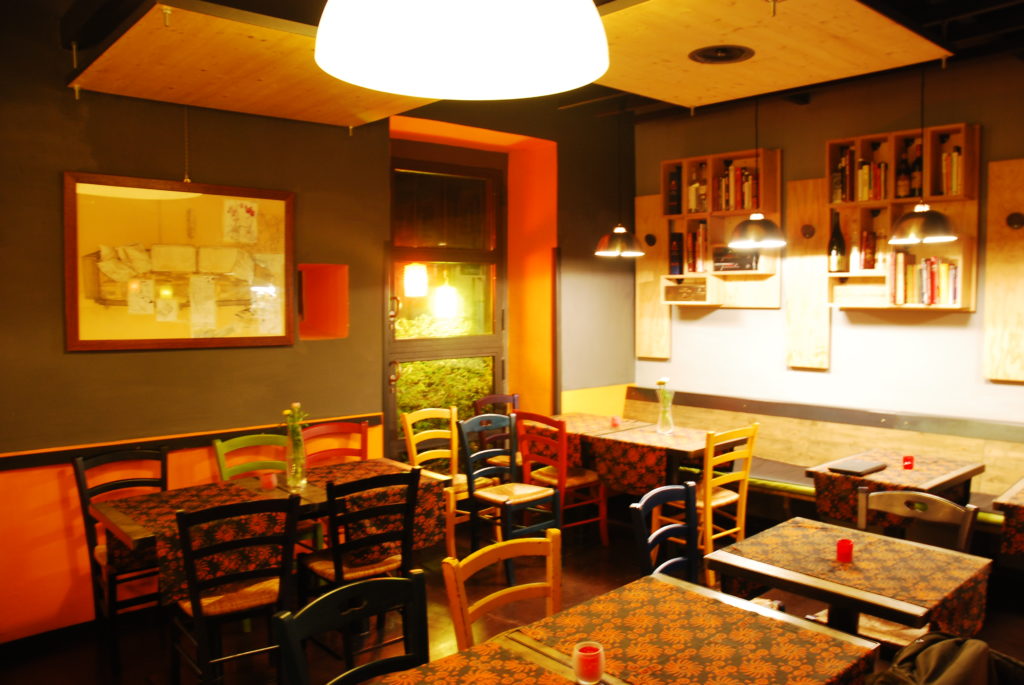
Infernotto’s interior (Photo: Infernotto)
As a gourmet street food joint, Premiata Panineria (Via Fanfulla da Lodi, 53) offers prime burgers sourced regionally, fish and chips, authentic Sicilian panelle and Danish cod served in a squid-ink bun. Bread and sauces are made on-site to match each recipe, while desserts and vegetarian options complete the menu. In the evening, find the door leading to Spirito, the in-house speakeasy equipped with roulette, a terrace and a quirky cocktail list. In summer the rooftop turns into a Hawaiian kiosk, where drinks and music get a tropical twist and aperitivo nibbles are provided by the underground Panineria.
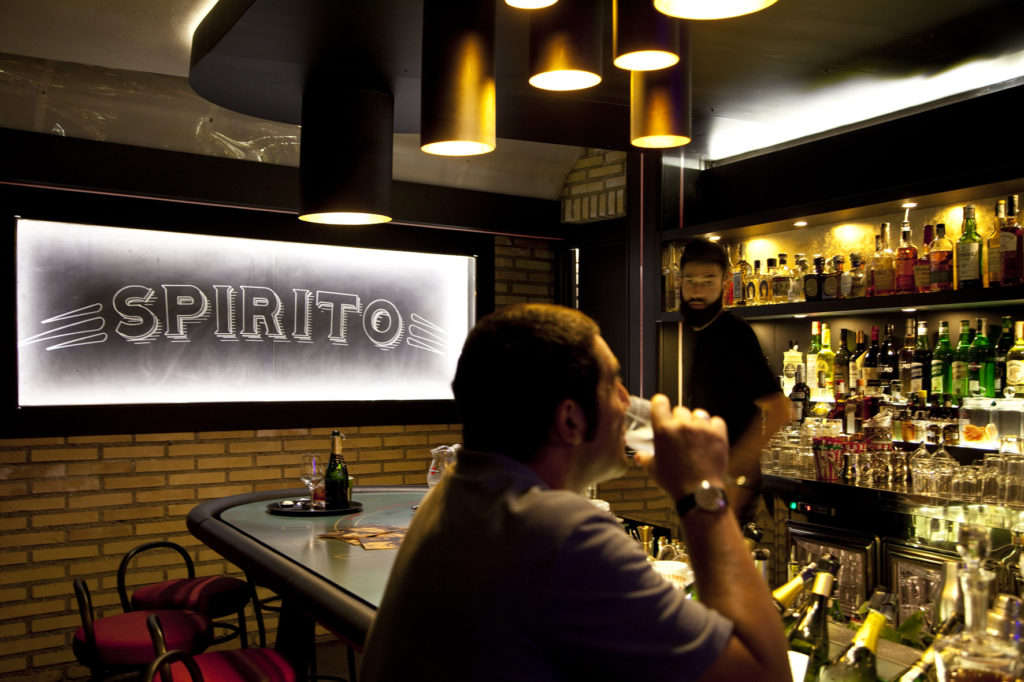
Spirito is one of Rome’s most renowned speakeasies (Photo: Spirito)
Roman-inflected street food is known as “pizza bianca”, the speciality of Opulentia (Via Ascoli Piceno, 44). Thanks to its low-yeast, slow-leavened recipe, this version of pizza by the slice is both light and crispy, perfect to be topped with all sorts of ingredients. The wide selection of cheeses, cured meats, fish, vegetables and sauces leads to heaps of inventive combinations. For an alternative, the menu also includes a club sandwich, soups, salads and tiramisu.
The standard-bearer of Pigneto’s veggie and vegan scene, Vitaminas 24 (Via Ascoli Piceno, 40), goes by the motto “made according to nature”. The colourful menu of this organic bistro boasts original salads, wraps, purées and soups, platters, hummus and desserts, while the tropical bar concocts an impressive variety of smoothies and juices. Saturday and Sunday brunch are served between 11.30am and 3.30pm, while aperitivo-time is livened up by Brazilian salgadinhos, which are savoury deep-fried snacks with varied fillings. Further Brazilian accent is to be found in the dessert section, which includes the rare-to-find energiser açaí na tigela.

Veggie burger at Vitaminas 24 (Photo: Vitaminas 24)
Live Music
Just around the corner from Pigneto metro station, Alvarado Street (Via Attilio Mori, 27) is a reference point in the area for live music and good beer. This street pub weekly features Italian and international bands spanning all variations of rock, blues, pop and singer-songwriting. In order to better enjoy the varied music programme, Alvarado’s taps pour a great selection of craft beers, in addition to the bottled options, which are daily blessed by happy hour prices. Foosball tournaments and live sport are also on the events list.
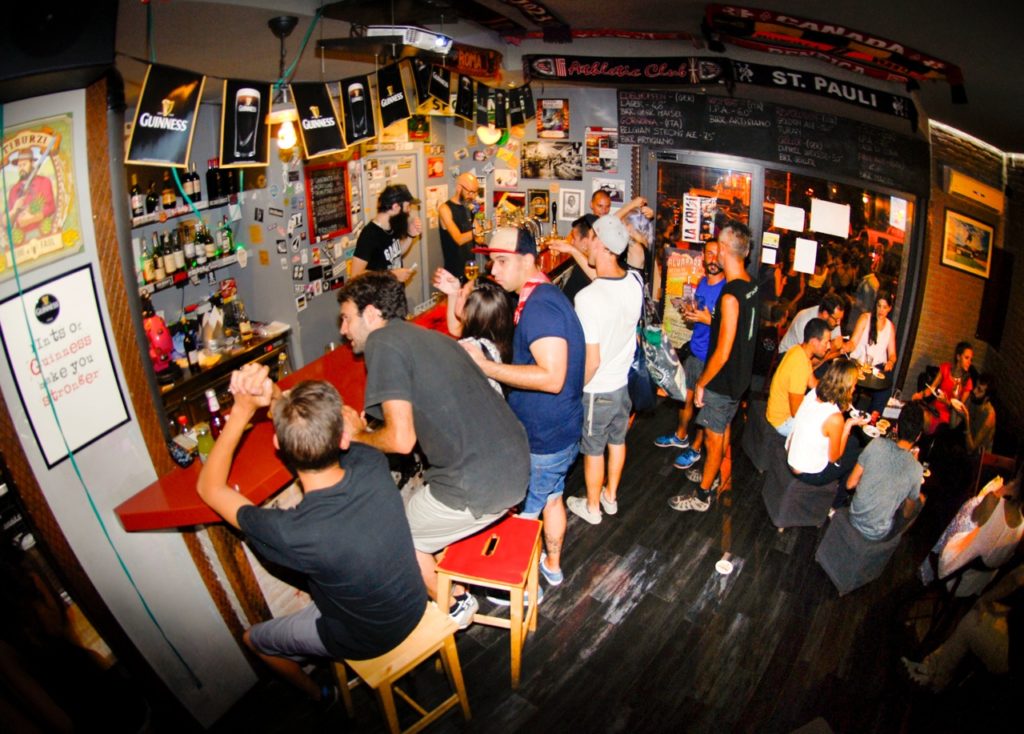
Alvarado Street is not always as quiet as it looks here (Photo: Alvarado Street)
Fanfulla 5/a (Via Fanfulla da Lodi, 5/a) promotes underground culture by welcoming a rich mix of DJs and live bands. Punk, rock, funk, pop and electro acts regularly appear in the monthly programme, while occasional independent cinema events also take place. Formerly housed in a much bigger venue, Fanfulla’s current space offers an intimate atmosphere which hasn’t affected its commitment to Rome’s underground art scene. Open daily until 3am, a membership card is required to enter.
Although Tramjazz doesn’t actually enter the neighbourhood, it does start and end on the outskirts of Pigneto (Piazza di Porta Maggiore). It’s a 3-hour experience across Rome aboard a historic cable car converted into a travelling restaurant and concert hall. As guests wind through spumante flutes, starters, beer and main courses, fine jazz musicians accompany their candlelit journey through different areas of the city, which reaches its peak in front of the Colosseum. Tramjazz takes place on Tuesdays, Fridays and Saturdays, and advance booking is required.